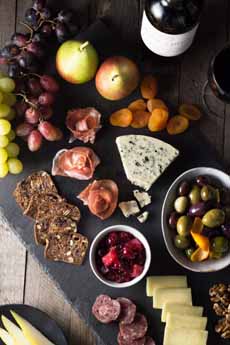TOP PICK OF THE WEEK: Sekt, Sparkling German Wine
|
Whenever the topic of Champagne comes up, for special occasions, gifting or fizzy cocktails, we like to remind everyone that there are delicious—and less costly—alternatives to Champagne. Consider these more affordable bubblies at half the price or less: Sekt is a German term for sparkling wines* (Sekts are also made in Austria). Finally, excellent Sekts from Germany are being imported into the U.S., and are waiting for you at fine wine stores in major markets. Sparkling wine accounts for 31% of Germany’s total wine production (Gewürtztraminer and Riesling account for most of the majority). And its Germans—not the French—who are the world’s biggest consumers of sparkling wine, consuming more sparkling wine per capita than any other people (not just Sekt, Champagne, Cava and Prosecco as well) [source]. The vast majority of Sekt produced is everyday, middle quality and isn’t imported into the U.S. in significant quantities. You don’t want that $10 bottle of Sekt. Instead, you want the 5% of Sekt that is rated premium in Germany, now available in the U.S. starting around $20 a bottle. Premium Sekt is made by the méthode traditionnelle that is used to make Champagne, although the grapes used and the terroir create very different flavors. You don’t get the famous toast-and-limestone flavors of Champagne, but instead, delicate biscuit and brioche accents. Some fruits are similar: apple, citrus, pear. Among the Sekt-producing regions—Mosel, Nahe, Pfalz, Rheinhessen and Rheingau—each has its own general flavor profile. Premium Sekt is made only from grapes from one of the 13 quality wine regions in Germany. These wines are labeled Sekt b.A, indicating a protected designation of origin wine region. The grapes used include Pinot Blanc, Pinot Gris, Pinot Noir† and Riesling. Some vintners have begun to use Chardonnay†. The majority of premium Sekts are single varietals. Premium Sekts are usually vintage dated with the vintner, and optionally the village and the vineyards. Those labeled Winzersekt (winegrower’s Sekt) are made by a producer who has vineyards of his/her own. Germany has a history of winemaking that dates back to 100 B.C.E., when the conquering Romans planted vineyards. During the Middle Ages, monks cultivated vineyards that are famous to this day. Historical properties like the Cistercian Monastery Kloster Eberbach in the Rheingau have a viticultural history dating back to about 1200 C.E. [source]. For many centuries, Germany and France were considered the two greatest wine producing countries in the world. The Noble Sweet wines of Germany, so-called because they were favored by the nobility—stood shoulder-to-shoulder with the classified growths of Bordeaux and Burgundy. These were the wines to collect and treasure. Germany produced (and still produces) fine dry Gewürtztraminer and Riesling along with their sweet counterparts. Alas, in the 1960s, the U.S. and other markets were flooded with large quantities of sweet blended wines that were created for export, including the now-infamous Blue Nun and Liebfraumilch (brands unknown in Germany). Advertising campaigns got people to buy them. Not knowing the difference, they served them with beef, pasta, and other foods that created a train wreck of pairings. So German wines—except the top Gewürtztraminers and Rieslings coveted by connoisseurs—went under the radar in the U.S. Sekt was unheard of in the U.S., except by people who knew it from Germany. German production of sparkling wines dates back to 1826, when Georg Christian Kessler returned from 16 years of working at the Champagne house Veuve Clicquot. If you’ve ever wondered why some of the best Champagne houses sound German—Bollinger, Krug, Piper-Heidsieck and Mumm, for example— it’s a result of Germans’ love of Champagne. In the early 19th century, numerous Germans traveled to Champagne to learn the technique of making sparkling wine. Some stayed to found what became famous houses. Initially, in Germany, sparkling wines could not be called Sekt. To make a long story short, a legal decision in the 1970s abolished the large producers’ monopoly on Sekt production, allowing winemaking cooperatives and individual winegrowers to produce and sell their own sparkling wines. And now, better Sekts from those winegrowers are appearing at wine stores and e-tailers in the U.S. Another legal decision enabled the name Sekt being for German sparkling wines [source]. Sekt pairs with everything you’d enjoy with another sparkling wine. Serve it with hard-to-pair foods like Asian and Indian cuisines, asparagus, and anything fried. Sekt loves cheeses, especially blues and the semisoft. |
|
|
|
Since Sekt brands are not familiar to most Americans, it’s better to ask for guidance from the store clerk. How about a Sekt tasting with different grape types, and different regions? That’s how we recently enjoyed a Sekt tasting of 15 different wines, courtesy of German Wines USA. Brands we loved: It was an eye-opener! The wines ranged from $20 to $50 a bottle. For $20 a bottle, the Fitz-Ritter is a wonderful aperitif, as is the Dr. Loosen for $25. For $22 and $27, respectively, the Hild Elbling and Von Winning are lovely food-pairing wines. *Some inexpensive German sparkling wines don’t meet the standards to be called Sekt. †Pinot Noir is one of the two major grapes, along with Chardonnay, that are used in France to make Champagne. Here are the different styles of Champagne, which have some analogies in Sekt. ‡Asti Spumante and Moscato d’Asti: the difference. Both wines hail from the area around the town of Asti in Piedmont, in northwest Italy. Both wines have the DOCG classification. Both have an alcohol by volume (A.B.V.) of 5.5% (11 proof). To put that into perspective, the average bottle of wine has 12% A.B.V. (24 proof). For this reason, both are good choices for light drinkers. Asti Spumante has lower, residual sugar but often seems sweeter than the Moscato d’Asti because great care is taken in the harvest and production so the sweet, sugary taste dominates the pronounced fruity Muscat character of the grape. Asti Spumante is made with the Charmat method: After the first fermentation, the wine undergoes a second fermentation in a sealed tank where the bubbles are created. The fermentation therefore takes longer than the fermentation of the Moscato d’Asti, which results in the lower residual sugar content [source]. With Moscato d’Asti, the grapes are immediately pressed when harvested. The juice is then filtered and stored in a cool place, and fermentation is only done when there is a wholesale demand for the wine (this way best preserves the fresh and fruity flavors and aromas). Fermentation takes place in a closed tank so that the carbon dioxide cannot escape and the wine gets its bubbles. When the wine has reached 5.5% alcohol, the fermentation is stopped by cooling, but part of the sugars in the grapes have not yet fermented. This is how Moscato gets its natural sweetness. CHECK OUT WHAT’S HAPPENING ON OUR HOME PAGE, THENIBBLE.COM. |
||








